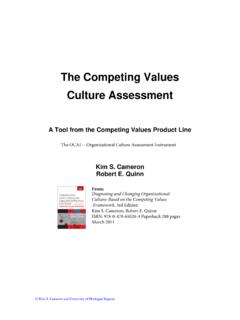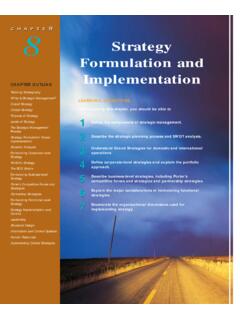Transcription of Seven Steps for Successful Change Management Strategy
1 Seven Steps for Successful Change Management Strategy A Workable Process for Change 2 Copyright jTask, Inc. 2016 1. The ACMP Standard for Change Management was published by the Association of Change Management Professionals in 2014. The entire ACMP Standard is available at 2. Italicization in this document reflects a direct quote from the ACMP Standard. Executive Summary The Association of Change Management Professionals (ACMP )1 Standard for Change Management 2 provides a thorough guide to developing a Change Management Strategy . The Standard was built from the ground up by a working group of over 1,100 Change Management thought leaders and volunteers from 57 countries, each averaging more than 10 years experience. In this document, jTask Inc. unpacks the ACMP Standard elements of Change Management Strategy , and adds our own advice as experts in Change Management , just as we do when working with our clients.
2 The ACMP Standard for Change Management separates the Change effort into five major areas that are: 1. Evaluate the Change Impact and organizational Readiness 2. Formulate the Change Management Strategy 3. Develop the Change Management Plan 4. Execute the Change Management Plan 5. Complete the Change Management Effort At jTask we think Formulate the Change Management Strategy is the most important part of the Change Management process. The Strategy needs to be correct for any Change implementation. We have explored the issues to help you select the right approach in each key step to build your Change Management Strategy . A New Approach to Change As a leader of your organization, you already know that Change is inevitable. Whether it's changing one step of a process, overhauling a department, or making a complete business transformation, Change is an important part of growth, development, and success.
3 Of course, Change is a complicated process, with the potential for great success or failure. It's too important to leave it to chance, do what you've always done, and hope everyone will get on board with the Change . You need a structured and comprehensive Strategy that can reliably bring you to the benefits of your Change . 3 The Association of Change Management Professionals (ACMP) recog-nized the need for consistency of process when they recently published the ACMP Standard for Change Management . This Standard codifies the best practices for managing Change in organizations, and provides a solid Change Management process. As Change Management professionals, we've reviewed the ACMP Standard thoroughly, and are now recommending it to all of our clients. There are many Change Management models, and many different ways to manage Change and transition. We believe the ACMP Standard is the best guide.
4 As we reviewed The Standard, we recognized that it would be useful for professionals facing a Change to have access to a detailed breakdown of one section of The Standard developing the Change Management Strategy . The ACMP Standard recommends creating a Change Management Strategy that encompasses Seven distinct areas of focus. At jTask Inc., we bring our considerable experience to The Standard, giving our clients our best advice to get the most out of it. The Standard identifies where Strategy is needed, We provide the things to consider in yours, based on our experience. Within your organization, there are already people and groups with knowledge domains for the Change team to draw on in order to be most effective. The people within your organization with sales, marketing, communication, training and project Management skills all have knowledge that can help inform and improve the Change Management process, including creating your Strategy .
5 For example, learning specialists can consult on your learning and development Strategy , sales and marketing specialists can coach you in engaging executive sponsors, and project managers can share their experience in managing complex scheduling requirements. Take advantage of this knowledge. Executive Summary 2 A New Approach to Change 2 Get Strategic 4 Seven Steps 4 Communication 4 Sponsorship 6 Stakeholder Engagement 8 Change Impact and Readiness 8 learning and Development 9 Measurement and Benefit Realization 10 Sustainability 11 About jTask 12 CONTENTS A Word About Risk Risk is an inherent part of business and any Change effort. The money and effort you put into your Change Management effort is based on the operational business risk. The higher the risk, the more you need to invest in your Change Management effort. There are several factors to consider to determine the operational risk.
6 These include: the strength of the case for Change the required amount of sponsor-ship engagement the degree to which the success of the project depends on behavior changes the degree to which the success of the project depends on stakehold-ers learning a new skill how much the Change affects stakeholders, customers, and ven-dors the amount of financial impact the Change has on the organization the amount of prior experience the organization has with Change When you understand the operational business risk of your Change , you will see where to expend the most effort. You may determine that there are ar-eas of your Strategy that will not re-quire any effort at all. When your analysis of the risk deter-mines that no effort should be ex-pended in a particular area, it is im-portant to document these decisions, so that as the Change is implemented all key team members and executives can understand the Strategy .
7 4 Copyright jTask, Inc. 2016 Get Strategic Our experience has shown us that some approaches aren't strategic enough they aren't comprehensive, they may not offer benchmarks or other measures, or they may leave out entire areas that are essential to managing a Change . This leaves your organization open to avoidable problems with the Change , including: Incomplete user adoption Unrealized benefits of the Change A Change Management process that is longer than necessary Wasted time and resources, and a loss of productivity Frustrated, disengaged stakeholders Instead of taking unnecessary chances with your Change Management process, using a comprehensive and strategic method will give you the best opportunities to see the benefits of your Change in reality. The Seven Steps to a Successful Change Management Strategy The Seven areas the ACMP Standard identifies as crucial to a Change Management Strategy are: 1.
8 Communication 2. sponsorship 3. stakeholder engagement 4. Change impact and readiness 5. learning and development 6. measurement and benefits realization 7. sustainability After you have selected your Strategy in all your areas identified in the ACMP Standard you will be able to develop your Change Management plan. Strategies do not need long and complex. The most Successful are often the simplest. As you develop you Strategy it is often about what you decide not to include not what you include. 1. Develop the Communication Strategy Part of the reason people often resist Change is because they don't understand exactly what is happening. By defining the Strategy of how you will communicate the Change throughout the Change Management process, you will provide a consistent, well-timed message. What About Workstreams? The ACMP Standard briefly discuss-es Change Management work-streams and highlights a list of them that includes sponsor accountabili-ties and activities, leadership align-ment, stakeholder engagement, communication, organization and process design, culture and behav-ior Change , impact assessment and Management , readiness planning, learning and development, perfor-mance Management , risk manage-ment, and benefit realization and sustainability Management .
9 As defined areas of your Change Management Strategy , workstreams can help you evaluate the status of your Change Management plan. You can use workstreams in a number of areas of your Strategy . For exam-ple in the sustainability area, you could list your workstreams and then determine what your approach is against each workstream over a quarter by quarter timeline, for a one or two year period.. 5 Developing the communication Strategy ensures that the organization and its customers are aware of and understand the organizational rationale for the Change ; ensures that stakeholders are aligned regarding the program's expected value and benefits to the organization, initiation, progress, challenges, achievements, completion, and realized benefits. Coaching sponsors and executives in your communication Strategy prevents misunderstandings that can impact your Change effort.
10 Imagine that you have created a communication Strategy that entails beginning Change communication with different regions at different times. While Change communication has begun at your headquarters already, it won't roll out in some regions for a few more months. If executives who aren't coached in the communication Strategy go on a roadshow, only to find out that employees in one of these regions seem to know nothing about the Change , they may draw incorrect and damaging conclusions. They might think the Change Management team is unfocused or behind on communicating the Change to this region. If they haven't been trained in communicating the Change , they may try to update this group of employees on their own, deviating from the messaging that has been decided on. Instead, if they understand that the plan is to begin Change communication to that region later on in the process, this can be avoided.






